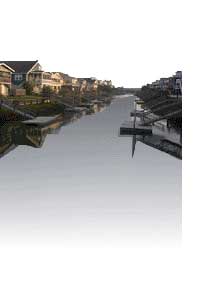Taking to the sky
Wide open spaces and clear skies also made the Valley a center of the
nation's blossoming love of airplanes and the people who flew them. Small dirt airfields popped up and lasted a few years
until the cash ran out. The 1920s and '30s also brought the opening of today's major airports, Burbank and Van Nuys, and the
exploits of Amelia Earhart. She lived in Toluca Lake with her husband, the publisher George Palmer Putnam, and often flew
above the Valley in planes made in Burbank by Lockheed.
The most glamorous airport of them all was Glendale's Grand
Central Terminal, where the first airliners to fly between New York and L.A. would drop off the stars. It was there that tycoon
Howard Hughes began his aircraft company. Hughes had also built and stocked two entire airfields, one at Balboa and Roscoe
boulevards and the other in Chatsworth, for the filming of Hell's Angels, his cinematic paean to World War I aviators.
War clouds
World War II, which the United States joined after the Japanese attack
on Pearl Harbor on Dec. 7, 1941, yanked the Valley into a new era. Farms gave way to airplane plants and to new homes by the
thousands.
Lockheed erupted into one of the war effort's most prolific assemblers
of bombers and fighters, becoming the Valley's biggest employer. As the men got drafted, the factory work was taken over by
women and high school students. They worked under giant camouflage nets hung over the plant, shifts running nonstop.
Some
3,177 residents of Japanese descent were taken from their homes — mostly farms — and interned at camps away from
the coast. So many Valley Japanese were at Manzanar that the camp had a baseball team called the San Fernando Aces. While
they were away, crops were picked by housewives, prisoners of war and workers brought from Mexico.
In 1944, the Army opened Birmingham Hospital for war wounded on Vanowen
Street in Van Nuys. The sprawling hospital held more than 1,000 maimed troops. That year, Bing Crosby's hit song "San Fernando
Valley" — from a movie of the same name, starring Roy Rogers — made the Valley sound even more heavenly to GIs
trapped overseas. The population swelled to 176,000 during the war.
